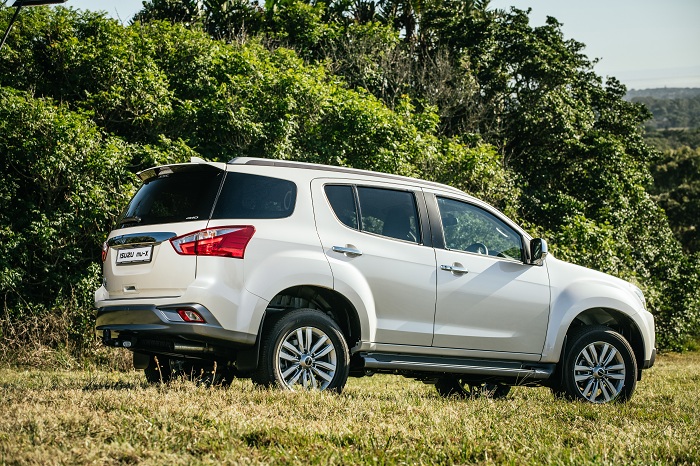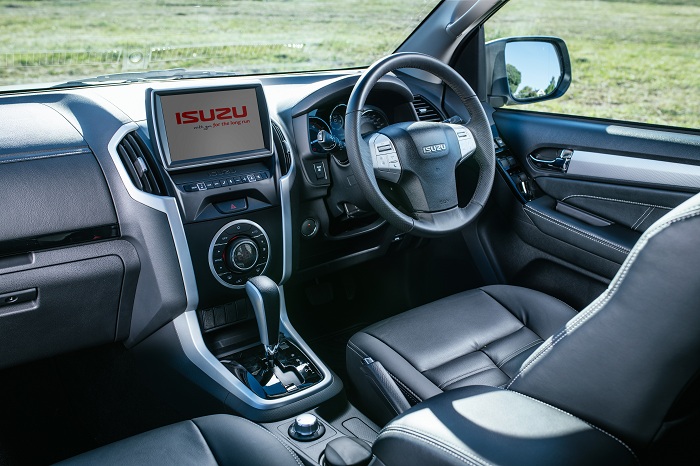More recently we’ve seen Mitsubishi release a mildly updated Pajero Sport, Haval enter the segment with the H9 and Isuzu enter the fray with the MU-X. The latter arrived or a weeklong stay recently and I decided to give it a go.
SUV styling

The MU-X is unmistakably Isuzu in its appearance, especially from the front where it has adopted the same grille and headlamp treatment as its KB sibling. The side profile and rear styling are pretty generic from a large SUV perspective, and show-off some of some of the car’s Chevrolet TrailBlazer DNA too. But then again, this market segment is less about aesthetics and more about space and practicality.
Interior
The interior of Izuzu is again, very similar to that of the KB and the TrailBlazer, with which it shares many components. The MU-X is slightly more upmarket than its bakkie sibling though with a more liberal use of leather and an increased emphasis on passenger space and comfort.
Counting in my test units favour though was the fact that it was fitted with the optional nine-inch infotainment system instead of the standard 6.5-inch item. With niceties such as an eight-speaker sound, Bluetooth, Apple CarPlay, Android Auto, two USB ports and satellite navigation, the infotainment setup is par for the course within the segment.

In terms of practicality, the MU-X has the segment stalwart Fortuner well and truly beaten, with a proper seven-seat design that allows or the third row of seats to be completely folded away when not needed, unlike the Toyota.
The second row also features good head and leg room as well as ventilation for occupants. While I personally wouldn’t like to be cooped up in the third row for an extended period, I suppose the same can be said for all seven seaters in this category.
Driving MU-X
Unlike its more established rivals from Ford and Toyota, the MU-X range makes do with a solitary engine and gearbox option in the form of the 3.0-litre turbodiesel and six-speed torque converter automatic. The unit delivers 130kW/380Nm and in combination with the slow gearbox, does make the MU-X feel lazy when attempting overtaking or when a quick burst of acceleration is required.
Being an old school motor, the 3.0-litre also emits quite an audible clatter. The MU-X does claw back in the refinement stakes with good cabin insulation and a respectable ride quality, no doubt attributed to its independent front- and multi-link rear suspension setup.
The benefit of this powertrain though is proven longevity with tried and tested mechanicals, while on the consumption front, the 4x4 variant tested here has a claimed fuel consumption of 7.9-litres/100km while in reality, I managed to achieve a figure of around 9.9-litres/100km.
In terms of off-road ability, the MU-X is expectedly competent with 230mm of ground clearance and impressive approach, break-over and departure angles. The rotary dial in the centre console allows for switching between 2H, 4H and 4L modes, depending on the prevailing conditions. I took the press unit through a muddy 4x4 course in my area and it simply sailed through, despite not featuring diff-lock, the traction control system is rather clever and mimics a pukka differential.
Verdict
The MU-X has certainly shown, much like its Mitsubishi rival did over a year ago, that there are solid alternatives to the Ford Everest and Toyota Fortuner. However, the South African buying public are very brand loyal and therefore a product needs to be exceptional to steal sales from the establishment. As competent as the MU-X is and as reliable and dependable it will likely prove to be, it only rates as competitive within the segment and is unlikely to tempt buyers from the more established contenders at the this stage.
















